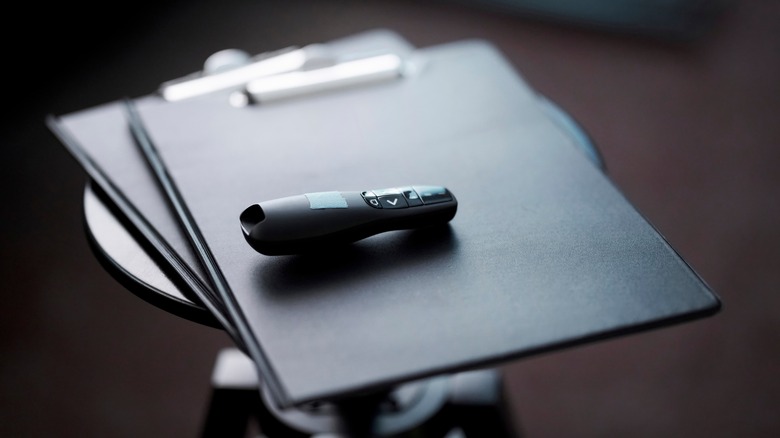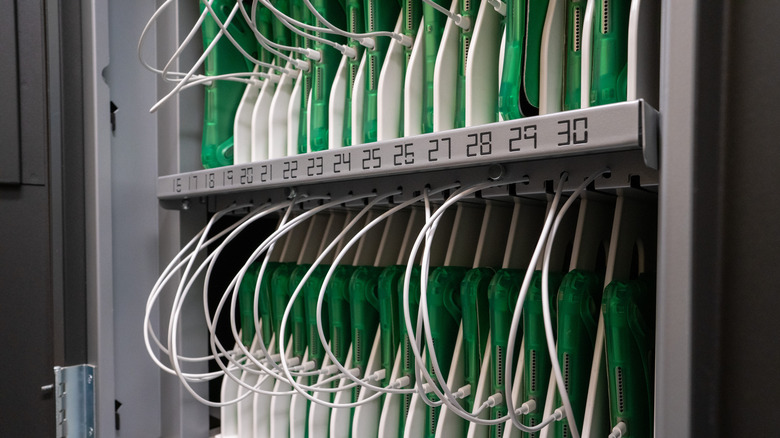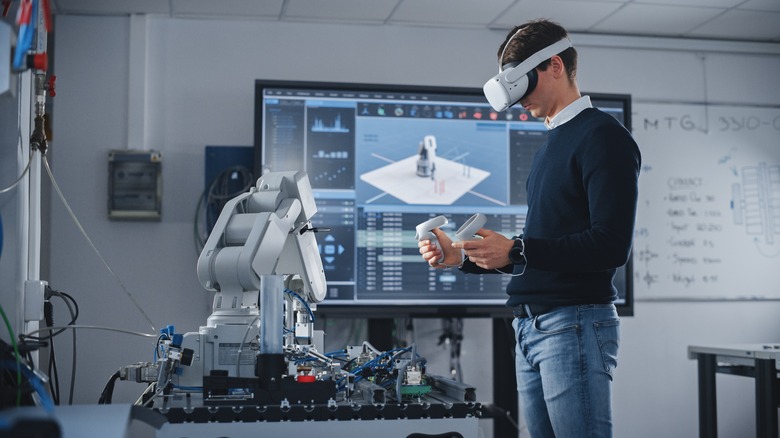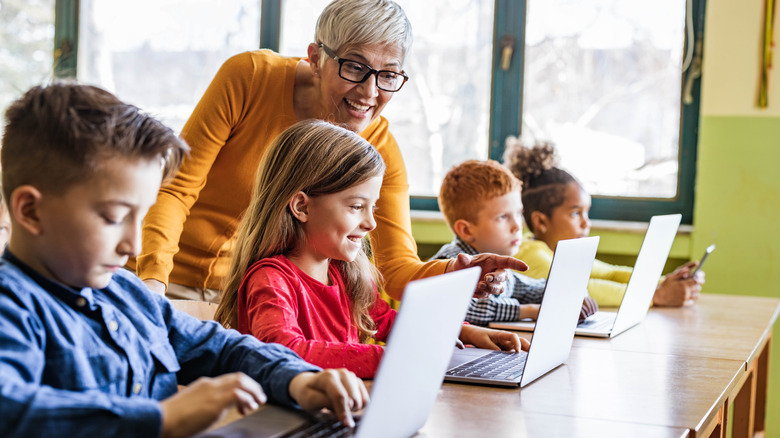10 Essential Tech Gadgets Every Classroom Should Have
We may receive a commission on purchases made from links.
As technology has advanced, its presence in the classroom has grown in tandem. Classroom and tech go hand in hand. It only makes sense that as students are taught, they become familiar with technology during the course of their studies. A classroom is one of the places where technology is most crucial, enhancing both students' education and teachers' capabilities.
We're looking at essential tech gadgets and applications that, ideally, every classroom should have. However, the reality is that classrooms and school districts vary widely in their resources. Some simply don't have the funding to provide some of the items they could really use. Even some of the world's most well-funded schools will face challenges in acquiring every item on this list.
Optimistically, as technology grows more affordable and readily available, we can expect the presence of such tools to become a regular feature in classrooms. Until then, let's outline the definitive tech wish list for contemporary education by exploring the essential tech gadgets every classroom should have.
Smart boards & projectors
Projectors have been a mainstay in most classrooms for quite some time, but when paired with smart boards they become much more useful in the classroom. Smart boards are durable touchscreens that replace traditional projection screens. While they often pair with specific projectors, some high-end versions function more like large touchscreen displays.
You can write on smart boards with regular dry-erase markers, but they also come equipped with electronic markers that allow color changes at will. With a suite of dynamic features, teachers can carry out numerous tasks directly on the smart board. Teachers can easily set up interactive games, quizzes, and more for students. These activities can be created on the fly, or preloaded by transferring files to the smart board.
Presentations and lectures come to life with the ability to upload videos, graphics, and other media. Any content displayed can be annotated with the smart board's pens, modified, and even cut and pasted, offering more versatility than a conventional whiteboard. Plus, different screens and settings can be saved and recalled, making it convenient for multiple class sessions.
Document cameras
The days of wheeling out a cart with an overhead projector are long gone. Document cameras have made them effectively obsolete by performing the exact same functions, but better. Document cameras are similar to overhead projectors but with much more functionality.
While both overhead projectors and document cameras project images onto larger screens, the latter actually digitizes the image. This means there's no need to fuss with adjusting a light source. Think of it as a specialized webcam, perfect for zooming in on documents like textbooks or handwritten notes.
Document cameras can transmit an image to smart boards, standard projectors, or even an online stream. Their flexibility makes teachers' lives so much easier: They can project from any location in the classroom, enabling students to manage pages while the teacher moves around, assisting or managing the class. There's no clutter of cables or excessive hardware in the way when using them at the front during lectures. They're a valuable tool for online education, making remote learning more interactive and engaging.
Presentation clickers
Teachers have two main types of clickers at their disposal for classroom use. The first type is the presentation clicker. Think of it as a combination of a remote mouse, controller, and laser pointer all in one compact device. Most teachers find these essential. They're handy during lectures, allowing teachers to navigate their presentations from any corner of the classroom. This mobility can aid in classroom management and individual student assistance. While basic models are affordable and do the job, pricier versions sync with multiple devices and control various classroom tech gadgets simultaneously.
The second variety is more common in higher education settings, especially during extended lectures. These clickers are small handheld devices designed to gather responses to multiple-choice questions from students. They offer a quick way to gauge understanding during a lecture and boost engagement. For instance, after asking a question, students can submit their answers, which the system then aggregates. These responses can be shown to the entire class anonymously, yet the teacher can still view individual responses. This method ensures that students can participate without the anxiety of public mistakes. Beyond academic checks, these clickers can also be used for trivia games or instant polls during discussions.
Charging stations
Ever since the Nokia 3310 introduced us to the game of Snake, teachers and cell phones have been bitter enemies. Students inevitably sneak phones into classrooms to text under their desks. While this may frustrate teachers to their core, perhaps it's time to change tactics and embrace them instead.
Cell phones, when used responsibly, can be valuable tools in the classroom. They can capture board notes and record lectures. Clearly outlining cell phone guidelines and ensuring transparency in their use is key for a safe and cooperative classroom.
That's where a classroom charging station comes in handy. During times when phone use is restricted, such as during exams, students can be prompted to dock their phones at the station. This not only reduces the temptation to hide phones but also instills a sense of responsibility. It also enables the teacher to monitor who has access to their phone, fostering a distraction-free learning environment.
Robotics kits
STEM education (it stands for Science, Technology, Engineering, and Math) is a top priority for schools. Institutions with outstanding STEM programs provide a competitive edge for students aspiring to enter these advanced fields.
A key component of effective STEM education is hands-on experience, as well as specialized equipment. That's why introducing robotics kits to students in a classroom setting can serve as an ideal introduction. These kits engage students in programming, engineering, and mathematics, capturing the essence of STEM in an enjoyable and interactive manner.
Robotics kits come in all shapes, sizes, and levels of complexity. For instance, introductory kits from LEGO cater to younger students, while advanced robotic kits for high school students demand more intricate technical knowledge and proficiency. The variety of building projects, challenges, and course supplements can give students the opportunity to explore a whole new field of study that will help prepare them for careers in the ever-evolving technological landscape.
VR labs
Virtual reality (VR) has transitioned from a concept of science fiction to a real-world technology. The only problem is that the technology is just now becoming more common. This makes it still very expensive, and applications for the classroom are only now starting to become more widely available.
However, available VR tech is growing and looks very promising for educational purposes. VR headsets tailored for classroom use are often more affordable, avoiding the high processing needs of commercial versions. Companies like Class VR and Foton VR are some of the best, developing applications to enhance the classroom experience.
With VR, students can delve deeper into their subjects. For example, in biology, they can explore human body systems or observe cellular processes up close.
Even though it's a relatively new addition to the classroom, VR has already been shown to be beneficial. When paired with traditional teaching methods, it can reinforce lessons and engage students more effectively. As remote learning becomes more common, VR offers an alternative that can simulate the experience of being in a classroom.
However, there are practical challenges. VR requires more room in classrooms, both to use and to store. While the idea of every student having their own VR headset is appealing, schools need to ensure there's enough space to use them safely.
Green screens
Green screens offer versatile applications in both traditional classrooms and remote learning environments. Notably, they're cost-effective, with even homemade versions — like green fabric on a PVC pipe frame — serving the purpose effectively, although commercial options are available too.
Green screens are perfect for project-based learning. Students can create presentations or plays that involve green screens, which help with immersion. Creating projects or plays that require students to virtually place themselves in their setting is a great example of embodied learning.
This approach not only deepens understanding of the material but also encourages active participation in the learning process. While embodied learning is a technique often associated with primary education, green screens make it relevant and engaging for older students as well.
In the context of project-based learning, green screens empower students with a degree of independence. They can do research to source images for the green screen, a process that promotes autonomy and enhances their investigative and problem-solving skills. This hands-on involvement in their education is helpful in promoting a deeper understanding of the material.
Karaoke machines/sound systems
Besides pulling double duty at the next all-hands training, a karaoke machine or combination microphone and sound system is an immensely useful tool for a classroom. Using a karaoke sound system, teachers can play background music during individual or group tasks, promoting a conducive learning environment. While any speaker can produce music, the added microphone ensures teachers can communicate effectively without resorting to raising their voices. This is especially beneficial in today's increasingly populated classrooms where a single teacher might oversee 30 students or more.
A microphone also helps with classroom management. When classrooms get chaotic and shouting teachers are commonplace, the ability to command attention with a controlled, amplified voice is an effective solution. It subtly establishes authority without being confrontational.
A microphone can also benefit student projects and presentations. Coupled with tools like smart boards, students can integrate musical or auditory elements. It also provides a platform for students to practice public speaking, especially for those who might be shy or soft-spoken, guiding them to develop confidence.
Digital pens
If budgetary constraints were not an issue, giving every student a digital pen would be immensely helpful. Digital pens are a clever fusion of AI and advanced camera technology that track the pen's movement. This data is then converted into a digital format, such as PDF.
In essence, everything a student writes gets digitized. This allows students to concentrate on jotting down notes during lectures. The integrated AI within the pen's software can transform these handwritten notes into formatted Word documents. This is the perfect blend of traditional methods and new technology coming together. Students not only sharpen their handwriting and note-taking skills but also benefit from an automatic conversion into neatly organized text documents.
Such a system allows for easy sharing of notes among study groups, fostering collaborative learning. Additionally, teachers can evaluate the quality and content of students' notes, which can contribute to participation grades. This also offers an opportunity for teachers to identify any areas where individual students might require additional support or guidance.
Laptops/tablets
Laptops are undoubtedly a powerful tool in the classroom. Many public schools have already adopted them for classroom use at the secondary level. The era where students needed to visit a computer lab for computer access is fast becoming a thing of the past. Although not every school has these resources yet, it's becoming increasingly common to see in middle and high school classrooms.
Laptops and tablets not only give students internet access, but also provide them with word-processing capabilities and access to student portals. These portals are important for managing assignments — students can view homework, submit it securely, and access a variety of educational software at no extra cost.
The shift toward digitization extends to standardized testing. Tests are now frequently administered on school-provided laptops. This approach ensures timely results and simplifies the exam proctoring process.
Equipping students with laptops isn't just about current classroom needs; it's about preparing them for the future. As computers permeate every facet of modern life, computer literacy has become a foundational skill. By ensuring students are computer-literate, schools not only set them up for future success but also alleviate financial pressure on lower-income families who may struggle to provide their children with suitable technology.










